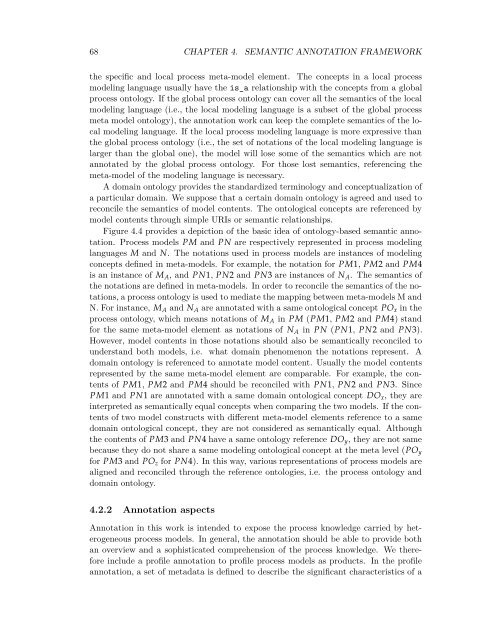Semantic Annotation for Process Models: - Department of Computer ...
Semantic Annotation for Process Models: - Department of Computer ...
Semantic Annotation for Process Models: - Department of Computer ...
You also want an ePaper? Increase the reach of your titles
YUMPU automatically turns print PDFs into web optimized ePapers that Google loves.
68 CHAPTER 4. SEMANTIC ANNOTATION FRAMEWORK<br />
the specific and local process meta-model element. The concepts in a local process<br />
modeling language usually have the is_a relationship with the concepts from a global<br />
process ontology. If the global process ontology can cover all the semantics <strong>of</strong> the local<br />
modeling language (i.e., the local modeling language is a subset <strong>of</strong> the global process<br />
meta model ontology), the annotation work can keep the complete semantics <strong>of</strong> the local<br />
modeling language. If the local process modeling language is more expressive than<br />
the global process ontology (i.e., the set <strong>of</strong> notations <strong>of</strong> the local modeling language is<br />
larger than the global one), the model will lose some <strong>of</strong> the semantics which are not<br />
annotated by the global process ontology. For those lost semantics, referencing the<br />
meta-model <strong>of</strong> the modeling language is necessary.<br />
A domain ontology provides the standardized terminology and conceptualization <strong>of</strong><br />
a particular domain. We suppose that a certain domain ontology is agreed and used to<br />
reconcile the semantics <strong>of</strong> model contents. The ontological concepts are referenced by<br />
model contents through simple URIs or semantic relationships.<br />
Figure 4.4 provides a depiction <strong>of</strong> the basic idea <strong>of</strong> ontology-based semantic annotation.<br />
<strong>Process</strong> models PM and PN are respectively represented in process modeling<br />
languages M and N. The notations used in process models are instances <strong>of</strong> modeling<br />
concepts defined in meta-models. For example, the notation <strong>for</strong> PM1, PM2 and PM4<br />
is an instance <strong>of</strong> M A , and PN1, PN2 and PN3 are instances <strong>of</strong> N A . The semantics <strong>of</strong><br />
the notations are defined in meta-models. In order to reconcile the semantics <strong>of</strong> the notations,<br />
a process ontology is used to mediate the mapping between meta-models M and<br />
N. For instance, M A and N A are annotated with a same ontological concept PO x in the<br />
process ontology, which means notations <strong>of</strong> M A in PM (PM1, PM2 and PM4) stand<br />
<strong>for</strong> the same meta-model element as notations <strong>of</strong> N A in PN (PN1, PN2 and PN3).<br />
However, model contents in those notations should also be semantically reconciled to<br />
understand both models, i.e. what domain phenomenon the notations represent. A<br />
domain ontology is referenced to annotate model content. Usually the model contents<br />
represented by the same meta-model element are comparable. For example, the contents<br />
<strong>of</strong> PM1, PM2 and PM4 should be reconciled with PN1, PN2 and PN3. Since<br />
PM1 and PN1 are annotated with a same domain ontological concept DO x , they are<br />
interpreted as semantically equal concepts when comparing the two models. If the contents<br />
<strong>of</strong> two model constructs with different meta-model elements reference to a same<br />
domain ontological concept, they are not considered as semantically equal. Although<br />
the contents <strong>of</strong> PM3 and PN4 have a same ontology reference DO y , they are not same<br />
because they do not share a same modeling ontological concept at the meta level (PO y<br />
<strong>for</strong> PM3 and PO z <strong>for</strong> PN4). In this way, various representations <strong>of</strong> process models are<br />
aligned and reconciled through the reference ontologies, i.e. the process ontology and<br />
domain ontology.<br />
4.2.2 <strong>Annotation</strong> aspects<br />
<strong>Annotation</strong> in this work is intended to expose the process knowledge carried by heterogeneous<br />
process models. In general, the annotation should be able to provide both<br />
an overview and a sophisticated comprehension <strong>of</strong> the process knowledge. We there<strong>for</strong>e<br />
include a pr<strong>of</strong>ile annotation to pr<strong>of</strong>ile process models as products. In the pr<strong>of</strong>ile<br />
annotation, a set <strong>of</strong> metadata is defined to describe the significant characteristics <strong>of</strong> a
















